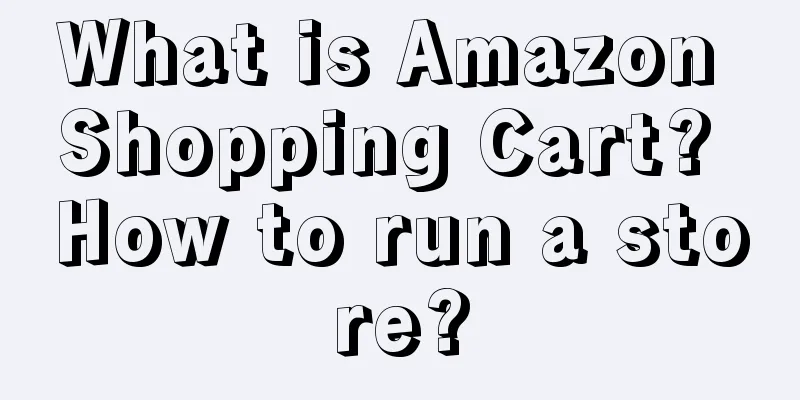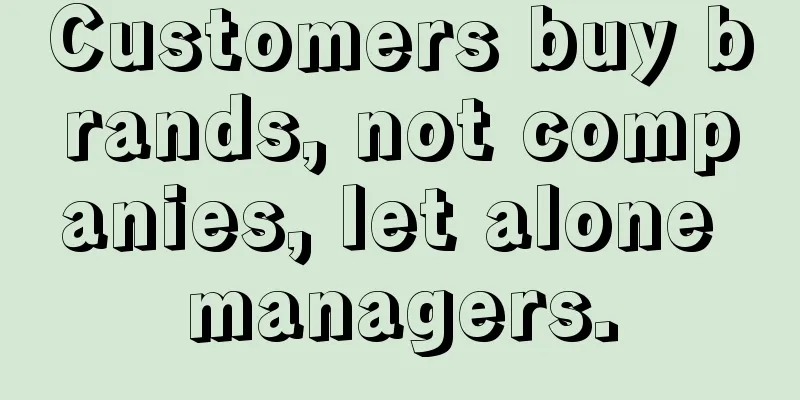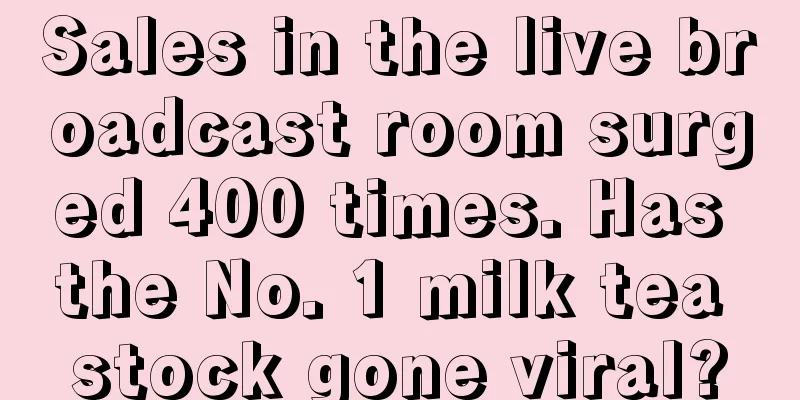How to quickly understand an industry?

Understand an industry and solve three major problems. 1. The killer feature of the solutionThe purpose of a solution is to solve the problem, and ideas can be found in the basic characteristics of the industry. Business sense is a natural talent that can’t be found easily; 99% of people still have to start from the basics of the industry and work their way up. If you don’t even have a good understanding of the basics of the industry, the plan you make will be like “water without a source, a tree without roots.” At the same time, you also lack the thinking dimension at the same level as your clients or bosses, so your plan will naturally be difficult to pass. 2. A stepping stone to enter Party AParty A needs you to have relevant industry experience, which is what we often talk about as “being on the same wavelength”. Being on the same wavelength is mainly based on the logic of reducing the rate of misjudgment and pursuing efficiency. The old saying "every industry has its own differences" means that there are great differences between different industries. There are some commonalities, but more of them are individual. Of course, for many people, the reality is that they really don't have experience in a certain industry at work. In this case, we can conduct proactive research on a certain industry. As we get closer to the industry, opportunities will naturally become bigger, and the quality of proactively solving problems in the process is also valuable, and may be favored for this reason. 3. Entry ticket to entrepreneurshipThere is a saying that goes, "People can only earn money within their knowledge." Choosing an industry that you are familiar with will naturally be more reliable. As the saying goes, "laymen see the excitement, experts see the details." Laymen often see the tip of the iceberg of an industry, while the real business undercurrent lies beneath the sea level. We need to understand an industry, and we need to understand it “quickly”. We will have to face such problems due to tight time and heavy tasks, or the extreme pursuit of efficiency. When we say quick understanding here, it is basically about a week, through a highly efficient way, to have a basic understanding of an industry. To have a deep understanding of the industry, you need to be involved in it for a long time. Of course, once you have the ability to quickly understand the industry, you will naturally be able to do your job with ease. The emergence of an industry requires demand and supply. When supply and demand are met, a certain market segment is created. The market will be affected by the external macro-environment, and the market is composed of competing players. When the market evolves and matures, the overview of the entire industry can be summarized. 1. Industry Overview1. Industry definitionIndustry definition means clarifying what the industry does and what needs of what people it meets. For example, the dermatology industry meets the specific skin care needs of people with sensitive skin. The products use gentle and scientific formulas, and emphasize product safety and professionalism. 2. Industrial Chain DistributionThe distribution of the industrial chain refers to the division of labor among the upstream, midstream and downstream, from the source of raw materials to the final delivery to consumers. Taking the cosmetics industry as an example, the upstream is the raw material suppliers and packaging material suppliers, the midstream is the manufacturers, and the downstream is the brand owners and channel operators. 3. Industry development historyThe development history of an industry is to look at the time of birth and reasons for the rise of different types of enterprises from a relatively long period of time. For example, the cosmetics industry has gone through six major stages of development, and these six stages are basically related to specific major events. 1) Extensive period (modern times started in the 1830s): The local cosmetics industry first emerged, such as Pechoin and Maxam. 2) Growth period (after reform and opening up): foreign investment poured in and domestic products developed, such as Procter & Gamble and Unilever, and Herborist. 3) Development period (the 1990s, when the idea of establishing a socialist market economic system was proposed, followed by the continuous emergence of domestic cosmetics brands): domestic products have been deeply involved in low-end channels and developed in a staggered manner with foreign capital, such as Marubi, Shanghai Jahwa, and PROYA. 4) E-commerce 1.0 era (the rise of e-commerce platforms represented by Taobao in 2006): Taobao brands first appeared, such as Afu Essential Oils, Mofashijia, and Yu Nifang. 5) E-commerce 2.0 era (the rise of flagship store B2C e-commerce platforms represented by Tmall in 2012): Foreign brands have successively entered Tmall, such as Estee Lauder, La Mer, YSL, etc. 6) E-commerce 3.0 era (various social media represented by Weibo, WeChat, Xiaohongshu, Douyin, Bilibili, etc. are all very popular): many cutting-edge domestic brands have emerged, such as Perfect Diary, HFP, etc. 4. Industry Development MapThe industry development map looks at the past and present category evolution charts from the perspective of category evolution, that is, user needs, to find the patterns and predict the future evolution direction. For example, in the coffee industry, from the perspective of drinking methods, it is divided into three major categories of coffee: instant, ready-to-drink, and freshly ground. In a broad sense, instant coffee is divided into concentrated coffee liquid (such as Yongpu), drip coffee (such as Sumida River), coffee capsules (such as Starbucks) and instant coffee in a narrow sense (such as Nestle, Santonban). In a narrow sense, instant coffee is divided into traditional instant coffee (such as Nestle) and freeze-dried coffee powder (such as Santonban). Freshly ground coffee is divided into comprehensive chain coffee (such as Starbucks), cost-effective coffee (such as Luckin Coffee) and boutique coffee (such as M Stand). 2. Macro-environment analysis1. Political conditionsIt depends on the relevant policies issued by the country and its attitude towards the industry. 2. Legal and industrial policiesIt is to see the impact of the policies issued by relevant departments on the industry. 3. Environmental protection relatedBecause environmental protection has been very popular in recent years, the recently popular ESG is also an important measure of corporate development. It mainly depends on the industry perspective to see whether production causes damage to the environment, the extent of the damage, and the degree of concern of consumers in this industry to the industry. 3. Market Analysis1. Market sizeThe market size determines the upper limit of everyone’s share. In a small market, the leader is also the loser. 2. Market growth rateIt is to see whether there is a possibility for this cake to become bigger. We can look at the future growth space from the past and the present. Generally, the compound annual growth rate can be used for prediction. For example, compound annual growth rate (CAGR). Calculation formula: CAGR (current value/base value)^(1/number of years) – 1 Example: Find the compound growth rate of cosmetics from 2015 to 2021. The total retail sales of cosmetics in 2015 and 2021 are 204.94 billion yuan and 402.6 billion yuan respectively. The compound annual growth rate = (4026/2049.4)^(1/6)-1=11.9% 3. Industry life cycleThe industry life cycle determines whether the industry is in the introduction stage, growth stage, maturity stage or decline stage through scale growth rate, technological status, number of competitors, entry barriers, and production and operation dimensions. Introduction stage: At this stage, the scale is small and the growth is slow; the technology is still unstable and immature; the number of competitors is relatively small; the entry barrier is relatively low; in production and operation, it is necessary to improve production efficiency and develop product standards; you can adopt a wait-and-see or participating strategy based on your own situation. Growth stage: At this time, the scale increases and the growth is rapid; the technology gradually stabilizes and becomes relatively mature; the number of competitors increases; the entry barriers begin to increase; in production and operation, product quality can be improved and the variety of colors and patterns can be increased; in terms of competitive strategy, key resources can be seized to increase market share. Mature stage: At this time, the scale is large and the growth rate is slowing down; the technology is mature and standardized production is implemented; the number of competitors begins to stabilize; the entry barriers are very high; it is necessary to strengthen customer relationships and reduce operating costs in production and operation; at this time, it is necessary to adopt competitive strategies such as cost reduction and efficiency improvement, mergers/expansion of scale, upgrading of old products, and development of new products. Decline stage: At this time, the scale declines and the growth rate is negative; the technology is inherited by other industries and substitutes appear; the number of competitors decreases; the entry barrier is very low; in production and operation, production capacity can be reduced to maintain price advantage; in terms of competitive strategy, timely exit is required. 4. Industry ProfitabilityWe should not only consider the size of the market, but also whether we can make money by entering the market. For example, we can consider the size of the gross profit margin. Generally speaking, a gross profit margin greater than 40% indicates a certain advantage, 20% to 40% indicates a highly competitive situation, and if it is less than 20%, it should be avoided as much as possible. 4. Competition Analysis1. Industry concentrationWe mainly look at CR4 and CR8. Generally speaking, the higher the industry concentration, the more disadvantageous it is for new players, because the top players control the minds of consumers and the core resources of the industry. Regarding the classification standards of industry concentration, please refer to the following figure: 2. Main competitors and success factorsAfter finding the benchmark competitors, we can list the scores of the five-dimensional radar chart based on the five key points of brand power, product power, channel power, marketing power, and capital power to help us analyze. 3. Industry barriersIf the barriers to competition in an industry are relatively low, then the number of players competing together will also be relatively high. Taking the sensitive skin industry as an example, it mainly includes six major barriers: brand barriers, scale operation barriers, talent barriers, product quality barriers, technical barriers and industry barriers. Brand barriers: Consumers are greatly influenced by factors such as brand image and advertising marketing when purchasing cosmetics. Barriers to large-scale operations: bargaining power is high for suppliers and distributors; sales channels are more convenient and faster; and continuous investment in R&D and production is guaranteed. Talent barrier: Cosmetics companies focus on the construction of brand planning, marketing, sales channels, product research and development and other fields. Product quality barriers: Since cosmetics act directly on the skin surface, their product quality is directly related to the physical health of consumers. As consumption concepts gradually mature, consumers' attention to the safety and professionalism of cosmetics is gradually increasing. Technical barriers (sensitive skin): People with sensitive skin are more sensitive to external stimuli such as environmental factors and seasonal changes, so they have higher requirements for the safety of skin care products. Industry barriers (sensitive skin): People with sensitive skin are cautious in choosing products and are generally reluctant to change them after applying them to their skin, so the product has strong customer stickiness. 4. Threat of substitutesWe also talk about competition analysis because in addition to the competition among peers, there will also be competition from other industries that meet the same user needs. In addition to the products directly in this industry, are there alternatives that meet the same needs of consumers, thus forming a certain competitive relationship? For example, when pork prices rise, people will turn to chicken and duck meat. V. Demand AnalysisThe demand side mainly includes the macro market size level and the micro user demand level. 1. Macro market size layerMarket size = population size x consumption frequency x payment price. Population size: How big is the overall target population? Consumption frequency: Is it a rigid demand? Is it a high frequency? Payment price: Willingness to pay the price. The lower limit is the economic foundation, and the upper limit is cultural insight. 2. Micro user demand layerIt mainly includes four key words: "user, scenario, problem, and solution". In one sentence, it means what kind of person, in what kind of scenario, what kind of problem they face, and what kind of solution they need. 6. Supply Analysis1. Supply chain: the degree of perfection of the supply chain and whether the product can be produced. 2. Product innovation: The promotion of new technologies or innovation in old technologies allow products to have their own “sales power”. 3. Product price: Is it acceptable to the target group? Sometimes, some categories are "prematurely innovative" and can easily become cannon fodder when the price is not acceptable. 4. Sales channel: Channel distribution influences consumer decision-making. It occupies shelf space, which is equivalent to occupying mental space. 5. Communication channels: Marketing promotion stimulates and further stimulates consumer demand. 6. Capital level: It has a promoting effect on the first five levels. Summarize:It takes years to study an industry, and a week is just to understand the "skin" of it, but this "skin" is the entry ticket that marketers must get first. I often meet some industry seniors who always have unique insights at the strategic level. In fact, this is due to their in-depth research on the industry. As Buffett said, "It took me only a few minutes to decide to invest in Anheuser-Busch, but I spent 25 years reading their annual reports." Author: Zang Feng, WeChat public account: Strategist Zang Feng |
<<: When you have an idea, you write it.
>>: Mental strength, mind, and heart capacity, 24 business rules
Recommend
Xiaohongshu’s Double 11 is a little different!
During this Double 11, Xiaohongshu brought a uniqu...
Where can I view my Amazon bill? Where can I view my income?
When opening a store online, the main thing is to ...
How does Pinduoduo drag down prices?
In the face of actual losses from production, how ...
How to set up a payment account on Shopee? Which payment account should I choose?
Shopee platform is one of the better developed cro...
The anchor with 2 million fans made tens of millions of GMV in his first live broadcast? The trust of "iron fans" made Kuaishou a dark horse in the rural areas track
With only one million fans, they were able to get ...
Is Lazada cross-border e-commerce real? Is it reliable?
There are many cross-border e-commerce platforms t...
How to choose China for shein address? What are the stations?
With the rapid development of the global e-commerc...
Is it necessary to pay the deposit of Shopee? What will happen if I don't pay it?
In fact, more and more people are now aware that c...
August overseas hot marketing calendar: seize these 7 nodes and let your products take off!
For e-commerce, games, interactive entertainment, ...
How to set up Amazon Prime Day discounts? Why can't I participate?
As a cross-border e-commerce platform, Amazon has ...
How to withdraw money from eBay? How to transfer money out of eBay?
No matter which platform you open a store on, merc...
4 steps: Build a private domain points system from 0 to 1
Everyone should have come into contact with points...
The era of "refund only" may be coming to an end. Following Taobao, Kuaishou e-commerce also stopped
With the booming e-commerce industry, the "re...
Lei Jun has nearly 7 million fans. In addition to using domineering internet celebrities, how else can car companies market themselves?
This article delves into how automakers use live s...
What is management? I rethought this question after starting my own business.
This article explores the relationship between man...









